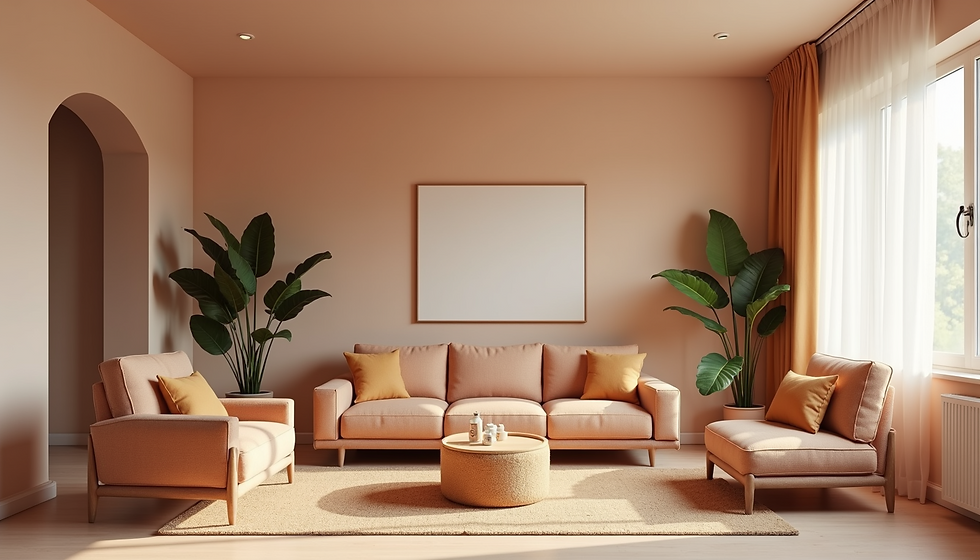INTERIOR DESIGN TRENDS TO WATCH IN 2025
- Be-Studio

- Jan 27
- 4 min read
Updated: May 6
Biophilic Design Takes Center Stage
Biophilic design, which integrates natural elements into interior spaces, is set to dominate 2025. As urbanization continues, people crave deeper connections with nature, leading designers to incorporate more organic materials, indoor plants, and natural light. Expect to see living walls, large windows with minimal treatments, and sustainable wood finishes. Water features, such as indoor fountains or aquariums, will also gain popularity as they enhance tranquility. The color palette will lean toward earthy tones—soft greens, warm browns, and muted blues—to create a calming atmosphere. Beyond aesthetics, biophilic design improves mental well-being and air quality, making it a key trend for homes and offices alike.

Technology will further enhance this trend with smart glass that adjusts transparency based on sunlight and automated plant-care systems. Furniture with natural textures, like rattan, jute, and stone, will replace cold, synthetic materials. Even artificial lighting will mimic natural patterns, with circadian rhythm-friendly bulbs that change throughout the day. As sustainability becomes non-negotiable, biophilic design offers a perfect blend of eco-consciousness and beauty, ensuring it remains a top trend in 2025.
Maximalism Makes a Bold Comeback
After years of minimalist dominance, maximalism is roaring back in 2025 with vibrant colors, bold patterns, and eclectic decor. This trend celebrates individuality, encouraging homeowners to mix textures, eras, and styles fearlessly. Think rich jewel tones like emerald green, sapphire blue, and deep burgundy paired with metallic accents. Layered rugs, oversized art, and statement furniture will define this look. Unlike cluttered spaces, maximalism in 2025 will be curated—each piece telling a story while maintaining harmony.

Wallpapers with dramatic prints, such as tropical botanicals or geometric designs, will cover entire rooms or serve as accent walls. Vintage and thrifted items will play a big role, aligning with sustainability trends. Open shelving filled with books, ceramics, and collectibles will replace sterile, empty spaces. Lighting will also be extravagant, with chandeliers, sculptural floor lamps, and neon signs adding personality. Maximalism isn’t just about excess; it’s about self-expression, making it a refreshing shift from the stark minimalism of previous years.
Sustainable and Circular Design
Sustainability is no longer optional—it’s a necessity. In 2025, interior design will prioritize circular design principles, focusing on recyclable, upcycled, and long-lasting materials. Furniture brands will adopt zero-waste production, using reclaimed wood, biodegradable textiles, and non-toxic finishes. Consumers will increasingly seek modular furniture that can adapt over time, reducing the need for replacements. Vintage and second-hand pieces will be highly valued, blending sustainability with unique style.

Energy-efficient homes will integrate solar panels, smart thermostats, and passive heating techniques. Designers will also emphasize local craftsmanship to reduce carbon footprints. Even paint choices will shift toward eco-friendly options with low VOC levels. The circular economy will influence decor, with rental and resale platforms for furniture gaining traction. As climate awareness grows, sustainable interiors will become the standard, proving that style and responsibility can coexist beautifully.
Smart Homes Get Smarter with AI Integration
The smart home revolution is evolving rapidly, and by 2025, artificial intelligence (AI) will play an even bigger role in interior design. Homes will no longer just be connected—they’ll be intuitive, learning residents’ habits and adjusting lighting, temperature, and even furniture layouts automatically. Voice-controlled systems like Alexa and Google Home will become more sophisticated, integrating seamlessly with built-in architectural elements. Imagine walls with embedded touch controls, self-adjusting ergonomic furniture, and AI-driven mood lighting that changes based on your daily rhythm.

Design-wise, technology will blend invisibly into interiors. Speakers will be hidden within walls, screens will double as digital art displays, and motorized partitions will redefine open-concept spaces. Smart kitchens will feature AI-assisted appliances that suggest recipes based on pantry inventory, while bathrooms may include mirrors with built-in health diagnostics. The key trend here is "invisible tech"—where functionality meets aesthetics without cluttering the space. As AI becomes more personalized, homes in 2025 will feel like true extensions of their inhabitants, anticipating needs before they arise.
Curved and Organic Shapes Replace Sharp Lines
Say goodbye to rigid, boxy furniture—2025 is all about soft, flowing forms. Inspired by nature and human-centric design, curved sofas, rounded arches, and organic silhouettes will dominate interiors. This trend emphasizes comfort and fluidity, creating spaces that feel more inviting and dynamic. Think oval dining tables, circular sectionals, and arched doorways that mimic natural curves. Even cabinetry and shelving will adopt rounded edges, reducing visual harshness.

This shift isn’t just about aesthetics; it’s rooted in psychology. Studies show that curved shapes evoke calmness and relaxation, making them ideal for modern living. Materials will follow suit, with plush, rounded upholstery and sculptural decor pieces. Lighting fixtures will feature globes, waves, and asymmetrical designs, adding an artistic touch. Whether in furniture, architecture, or decor, the "post-geometric" movement will redefine how we perceive space, making homes feel cozier and more harmonious.
Tactile & Sensory Design for Well-Being
In 2025, interiors will prioritize sensory experiences, engaging touch, sight, and even sound. Designers will focus on textural contrast—rough stone against smooth velvet, cool metal beside warm wood. This trend aligns with wellness movements, as varied textures can reduce stress and stimulate creativity.

Expect to see:
Sound-absorbing materials (acoustic panels disguised as art)
Heated flooring & dynamic temperature zones
Interactive walls (kinetic art, magnetic paint for customizable decor)



